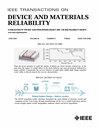4H-SiC Trench Gate Lateral MOSFET With Dual Source Trenches for Improved Performance and Reliability
IF 2.5
3区 工程技术
Q2 ENGINEERING, ELECTRICAL & ELECTRONIC
IEEE Transactions on Device and Materials Reliability
Pub Date : 2022-11-16
DOI:10.1109/TDMR.2022.3222909
引用次数: 0
Abstract
The SiC trench gate lateral MOSFET featuring dual source trenches is proposed in this work. 2D numerical simulations by TCAD are conducted to study the performance and the reliability of the proposed structure and the conventional ones. With the trench gate, the device specific ON-resistance is reduced by more than 50% compared to that of the planar gate device. The device with proposed dual source trenches can also prevent the Pwell punch through problem that occurs in conventional lateral LMOS. As a result, a blocking voltage over 1200V can be achieved with the proposed structure. The proposed devices have two types of configurations. Compared with the configuration of double shallow trenches, the configuration of deep and shallow trenches can mitigate the curvature effect near the P+ source region by increasing the effective curvature radius. As a result, the RESURF doping and epi thickness windows are both expanded by具有双源沟槽的4H-SiC沟槽栅横向MOSFET,可提高性能和可靠性
本文提出了一种具有双源沟槽结构的SiC沟槽栅横向MOSFET。利用TCAD软件进行了二维数值模拟,研究了该结构与传统结构的性能和可靠性。与平面栅极器件相比,沟槽栅极器件的导通电阻降低了50%以上。采用双源沟槽的装置还可以防止常规横向LMOS中出现的Pwell冲穿问题。因此,采用所提出的结构可以实现超过1200V的阻塞电压。建议的设备有两种类型的配置。与双浅沟配置相比,深沟和浅沟配置可以通过增加有效曲率半径来缓解P+源附近的曲率效应。结果,RESURF掺杂和epi厚度窗口均扩大了1.5{\times}$。此外,由于深源沟槽推动电场远离栅极沟槽,非状态氧化场有效地降低到3MV/cm以下。因此,长期可靠性大大提高。此外,深源沟槽和浅源沟槽配置提供了增强的屏蔽效应,因此降低了50%的栅极电荷。使用这种结构可以实现更快的切换。
本文章由计算机程序翻译,如有差异,请以英文原文为准。
求助全文
约1分钟内获得全文
求助全文
来源期刊

IEEE Transactions on Device and Materials Reliability
工程技术-工程:电子与电气
CiteScore
4.80
自引率
5.00%
发文量
71
审稿时长
6-12 weeks
期刊介绍:
The scope of the publication includes, but is not limited to Reliability of: Devices, Materials, Processes, Interfaces, Integrated Microsystems (including MEMS & Sensors), Transistors, Technology (CMOS, BiCMOS, etc.), Integrated Circuits (IC, SSI, MSI, LSI, ULSI, ELSI, etc.), Thin Film Transistor Applications. The measurement and understanding of the reliability of such entities at each phase, from the concept stage through research and development and into manufacturing scale-up, provides the overall database on the reliability of the devices, materials, processes, package and other necessities for the successful introduction of a product to market. This reliability database is the foundation for a quality product, which meets customer expectation. A product so developed has high reliability. High quality will be achieved because product weaknesses will have been found (root cause analysis) and designed out of the final product. This process of ever increasing reliability and quality will result in a superior product. In the end, reliability and quality are not one thing; but in a sense everything, which can be or has to be done to guarantee that the product successfully performs in the field under customer conditions. Our goal is to capture these advances. An additional objective is to focus cross fertilized communication in the state of the art of reliability of electronic materials and devices and provide fundamental understanding of basic phenomena that affect reliability. In addition, the publication is a forum for interdisciplinary studies on reliability. An overall goal is to provide leading edge/state of the art information, which is critically relevant to the creation of reliable products.
 求助内容:
求助内容: 应助结果提醒方式:
应助结果提醒方式:


